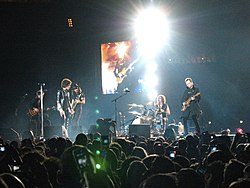This article has multiple issues. Please help improve it or discuss these issues on the talk page . (Learn how and when to remove these messages)
|
Spanish rock is the term used for the variety of rock music produced in Spain. Most bands formed in Spain have sung in Spanish, but many others have sung in English, French and Italian, in addition to the other languages spoken in Spain, such as Catalan, Galician, Basque, Aragonese, and Asturian.


